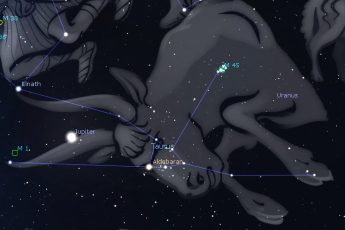This Week’s Sky at a Glance, 2024 Nov 23 – Nov 30
This Week’s Sky at a Glance, 2024 Nov 23 – Nov 30
The constellation of Taurus the Bull has completely cleared the eastern horizon by 6:30 pm this week. It is distinguished by two relatively close star clusters: the compact dipper-shaped Pleiades (M45) in the bull’s shoulder and the V-shaped Hyades that forms the bull’s face. The bright orange star Aldebaran anchors one side of the V, representing the bull’s fiery eye, but it is not actually part of the cluster as it is much closer. In mythology the Pleiades (aka the Seven Sisters) and the Hyades were half-sisters; daughters of Atlas, who obviously didn’t spend all his time holding up the sky.
Starting from the apex of the Hyades, extend each side of the V outward to a star. These stars are the tips of the bull’s horns. The upper star is Elnath, which forms one of the corners of Auriga the Charioteer although it is officially part of Taurus. The other horn star has a famous dim neighbour, which is about one degree away and slightly to the right of a line joining the horns. Called the Crab Nebula or M1 for being the first entry in Charles Messier’s 18th century catalogue, this little fuzzy patch is a gaseous supernova remnant. The supernova, a death-explosion of a giant star, was seen in daylight for three weeks in 1054. I have seen M1 in a transparent sky with binoculars but a telescope gives a better view. Jupiter will spend the winter between the long horns of Taurus, which is near the highest point of the ecliptic.
This Week in the Solar System
Saturday’s sunrise in Moncton is at 7:31 and sunset will occur at 4:39, giving 9 hours, 8 minutes of daylight (7:33 and 4:47 in Saint John). Next Saturday the Sun will rise at 7:40 and set at 4:35, giving 8 hours, 55 minutes of daylight (7:42 and 4:43 in Saint John). The Moon is at third quarter on the evening of November 22 and it doesn’t reach the new phase until the morning of December 1. This indicates that it spends the week near its farthest distance from Earth (apogee on Tuesday), during which its orbital speed is slowest. Around 6:30 Wednesday morning you might notice the bright star Spica very near the Moon, binoculars will help. Within a half hour the Moon will pass in front of it.
Mercury begins moving sunward, setting an hour after sunset this weekend and 40 minutes after sunset next Saturday. Brilliant Venus can be seen in the southwest soon after sunset, slowly gaining altitude nightly. Saturn is at its highest and best for observing by 7 pm, showing its rings nearly edge on. Jupiter rises half an hour after sunset, and telescope users might observe its Red Spot around 10 pm Monday and 7:40 pm Thursday. Now brighter than any star except Sirius, Mars is within a binocular view above the Beehive star cluster all week, and it is close enough to Earth to reveal features through a telescope.
Tune in to the Sunday Night Astronomy Show at 8 pm on the YouTube channel and Facebook page of Astronomy by the Bay.

